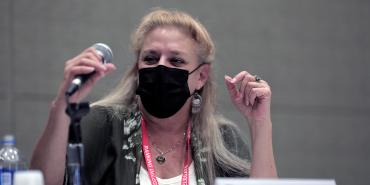It was all about creating more equitable schools at the teachers’ divisional meeting July 14. Diving into the AFT’s work with community schools, career and technical education and the educator and school staff workforce shortage, the session shared concrete pathways to equity—and past the challenges that have recently plagued the teaching profession.
School equity is disrupted in many ways, said Ellen Bernstein, president of the Albuquerque Teachers Federation and co-chair of the program and policy council for AFT teachers. Among the key culprits she cited are testing, labeling and segregating young children and providing inferior education to students living in poverty and children of color. “It’s time for us as a union not just to question these practices,” said Bernstein. “It’s time to change it.”
Shari Obrenski, president of the Cleveland Teachers Union and a PPC co-chair, told participants they’d hear all about how the AFT “can help fulfill the promise of educational opportunity” for all.
Funding is a one part of the solution. “Money matters,” said Donna Chiera, president of AFT New Jersey. “But how you spend it also matters.” When teachers and school staff had a voice in New Jersey education funding, schools had guidance counselors and school nurses. Those positions began to disappear when leadership shifted. “Elections matter,” added Chiera. “It all went out the window with one election of a governor who did not believe in public education.”
Community schools make a big difference as well, ensuring children and families get the services they need in order to learn and thrive. Federal support for these community hubs has increased, with grants increasing from $30 million to $75 million; $189.5 billion in pandemic relief funds; and other funding through Title I, Title II and Title IV. New grants are available now, with applications due Sept. 12.
Meanwhile, the AFT provides its own support through the community schools network, an e-learning community with the latest research, case studies and materials, access to advice from knowledgeable staff and a monthly webinar series on community schools.
Another key pathway to addressing the needs of all students is career and technical education, which Bernstein called “not just an equity strategy” but “a necessary strategy to rebuild the middle class and make sure we engage young people in all kinds of things that they’re truly interested in.” Not only does CTE provide an alternative to college, said Jan Hochadel, president of AFT Connecticut and an AFT vice president, it also reduces the dropout rate.
Hochadel was part of an AFT delegation that visited Germany to learn more about vocational education and training programs there. They were impressed by the variety of offerings—there were 325 recognized training programs—as well-paid internships and apprenticeships, and partnerships among unions, corporations, schools and government.
Finally, divisional meeting participants learned about solutions to the educator and school staff shortage from the co-chairs of the AFT task force formed to address it. Carl Williams, president of the California Federation of Teachers Council of Classified Employees, co-chair of the task force and an AFT vice president, described the primary focuses of the task force’s report, “Here Today Gone Tomorrow”: enhancing the educator and school staff pipeline; creating positive working and learning conditions for all; giving workers time, trust, tools and training; and providing sustainable compensation and benefits. The task force will present a resolution Friday regarding the issue.
“It is time for the AFT to make a statement about what we should be doing in terms of the crisis we are all facing,” said Michael Mulgrew, president of United Federation of Teachers, co-chair of the task force and an AFT vice president. “We are losing teachers. We are losing staff.
[Virginia Myers/photo by Pamela Wolfe]

